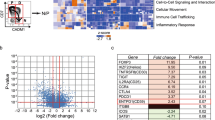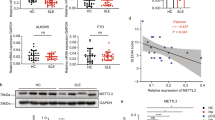Abstract
The RNA editing adenosine deaminase gene (ADAR1) expression is wide-spread in lymphocytes. We explore the mechanism of ADAR1 regulation on the function of T primary lymphocytes when rejection occurs by knock-down the expression of ADAR1 in mouse T primary lymphocytes in mixed lymphocyte cultures. The changes of cell proliferation, the expression of ADAR1 and the cell cycle related genes cyclin D1 and A1, cell cycle and apoptosis analysis and mouse gene expression profiles was evaluated. We found that treatment with ADAR1-specific siRNA inhibited allogenic antigen stimulated T cell proliferation, arrested T cell cycle at G0/G1 phases and promoted T cell apoptosis, which was associated with down-regulation of some related key genes transcription. These findings suggest that ADAR1 is essential for the maintenance of function of T lymphocytes during acute rejection. The mechanism underlying ADAR1’s action might include editing of a currently unknown substrate and interacting with other proteins.







Similar content being viewed by others
References
Aw MM, Verma A, Rela M et al (2008) Long-term outcome of mycophenolate mofetil rescue therapy for resistant acute allograft rejection in pediatric liver transplant recipients. Liver Transpl 14(9):1303–1308
Cardell M, Jung FJ, Zhai W et al (2008) Acute allograft rejection and immunosuppression: influence on endogenous melatonin secretion. J Pineal Res 44(3):261–266
Demirhan B, Bilezikci B, Haberal AN et al (2008) Hepatic parenchymal changes and histologic eosinophilia as predictors of subsequent acute liver allograft rejection. Liver Transpl 14(2):214–219
Nie Y, Ding L, Kao PN et al (2005) ADAR1 interacts with NF90 through double-stranded RNA and regulates NF90-mediated gene expression independently of RNA editing. Mol Cell Biol 25(16):6956–6963
Samuel CE (1998) Reoviruses and the interferon system. Curr Top Microbiol Immunol 233(Pt 2):125–145
Wang Q, Miyakoda M, Yang W et al (2004) Stress-induced apoptosis associated with null mutation of ADAR1 RNA editing deaminase gene. J Biol Chem 279(6):4952–4961
Nie Y, Hammond GL, Yang JH (2007) Double-stranded RNA deaminase ADAR1 increases host susceptibility to virus infection. J Virol 81(2):917–923
Rabinovici R, Kabir K, Chen M et al (2001) ADAR1 is involved in the development of microvascular lung injury. Circ Res 88(10):1066–1071
Yang JH, Luo X, Nie Y et al (2003) Widespread inosine-containing mRNA in lymphocytes regulated by ADAR1 in response to inflammation. Immunology 109(1):15–23
Yang JH, Nie Y, Zhao Q et al (2003) Intracellular localization of differentially regulated RNA-specific adenosine deaminase isoforms in inflammation. J Biol Chem 278(46):45833–45842
Wang Q, Khillan J, Gadue P et al (2000) Requirement of the RNA editing deaminase ADAR1 gene for embryonic erythropoiesis. Science 290(5497):1765–1768
Hartner JC, Schmittwolf C, Kispert A et al (2004) Liver disintegration in the mouse embryo caused by deficiency in the RNA-editing enzyme ADAR1. J Biol Chem 279(6):4894–4902
Wang H, Hou Z, Wu Y et al (2006) p150 ADAR1 isoform involved in maintenance of HeLa cell proliferation. BMC Cancer 6:282
Tomasoni S, Remuzzi G, Benigni A (2008) Allograft rejection: acute and chronic studies. Contrib Nephrol 159:122–134
Yuling H, Ruijing X, Xiang J et al (2008) Essential role of sphingosine-1-phosphate receptor 1-bearing CD8+ CD44+ CCR7+ T cells in acute skin allograft rejection. Am J Transplant 8(7):1401–1412
Falck P, Asberg A, Guldseth H et al (2008) Declining intracellular T-lymphocyte concentration of cyclosporine a precedes acute rejection in kidney transplant recipients. Transplantation 85(2):179–184
Hall BM, Robinson CM, Plain KM et al (2008) Studies on naive CD4+ CD25+ T cells inhibition of naive CD4+ CD25- T cells in mixed lymphocyte cultures. Transpl Immunol 18(4):291–301
Zahn RC, Schelp I, Utermohlen O et al (2007) A-to-G hypermutation in the genome of lymphocytic choriomeningitis virus. J Virol 81(2):457–464
Hartwig D, Schutte C, Warnecke J et al (2006) The large form of ADAR 1 is responsible for enhanced hepatitis delta virus RNA editing in interferon-alpha-stimulated host cells. J Viral Hepat 13(3):150–157
Patterson JB, Thomis DC, Hans SL et al (1995) Mechanism of interferon action: double-stranded RNA-specific adenosine deaminase from human cells is inducible by alpha and gamma interferons. Virology 210(2):508–511
Longacre A, Storb U (2000) A novel cytidine deaminase affects antibody diversity. Cell 102(5):541–544
Muramatsu M, Kinoshita K, Fagarasan S et al (2000) Class switch recombination and hypermutation require activation-induced cytidine deaminase (AID), a potential RNA editing enzyme. Cell 102(5):553–563
Neuberger MS, Scott J (2000) Immunology. RNA editing AIDs antibody diversification? Science 289(5485):1705–1706
Eytan E, Braunstein I, Ganoth D et al (2008) Two different mitotic checkpoint inhibitors of the anaphase-promoting complex/cyclosome antagonize the action of the activator Cdc20. Proc Natl Acad Sci U S A 105(27):9181–9185
Kidokoro T, Tanikawa C, Furukawa Y et al (2008) CDC20, a potential cancer therapeutic target, is negatively regulated by p53. Oncogene 27(11):1562–1571
Bassermann F, Frescas D, Guardavaccaro D et al (2008) The Cdc14B-Cdh1-Plk1 axis controls the G2 DNA-damage-response checkpoint. Cell 134(2):256–267
Berdougo E, Nachury MV, Jackson PK et al (2008) The nucleolar phosphatase Cdc14B is dispensable for chromosome segregation and mitotic exit in human cells. Cell Cycle 7(9):1184–1190
Yamaguchi M, Fujimori-Tonou N, Yoshimura Y et al (2008) Mutation of DNA primase causes extensive apoptosis of retinal neurons through the activation of DNA damage checkpoint and tumor suppressor p53. Development 135(7):1247–1257
Huang H, Fletcher L, Beeharry N et al (2008) Abnormal cytokinesis after X-irradiation in tumor cells that override the G2 DNA damage checkpoint. Cancer Res 68(10):3724–3732
Liljeroos M, Vuolteenaho R, Rounioja S et al (2008) Bacterial ligand of TLR2 signals Stat activation via induction of IRF1/2 and interferon-alpha production. Cell Signal 20(10):1873–1881
Unutmaz D, Vilcek J (2008) IRF1: a deus ex machina in TH1 differentiation. Nat Immunol 9(1):9–10
Ahmad R, Raina D, Meyer C et al (2008) Triterpenoid CDDO-methyl ester inhibits the Janus-activated kinase-1 (JAK1)—signal transducer and activator of transcription-3 (STAT3) pathway by direct inhibition of JAK1 and STAT3. Cancer Res 68(8):2920–2926
Xiang Z, Zhao Y, Mitaksov V et al (2008) Identification of somatic JAK1 mutations in patients with acute myeloid leukemia. Blood 111(9):4809–4812
Jeong EG, Kim MS, Nam HK et al (2008) Somatic mutations of JAK1 and JAK3 in acute leukemias and solid cancers. Clin Cancer Res 14(12):3716–3721
Shields BJ, Court NW, Hauser C et al (2008) Cell cycle-dependent regulation of SFK, JAK1 and STAT3 signalling by the protein tyrosine phosphatase TCPTP. Cell Cycle 7(21):3405–3416
Steiger SS, Fidler AE, Valcu M et al (2008) Avian olfactory receptor gene repertoires: evidence for a well-developed sense of smell in birds? Proc Biol Sci 275(1649):2309–2317
Cook BL, Ernberg KE, Chung H et al (2008) Study of a synthetic human olfactory receptor 17–4: expression and purification from an inducible mammalian cell line. PLoS ONE 3(8):e2920
Acknowledgments
This work was supported by Natural Science Foundation of China Grants No. 30271281; No. 30170923; No. 30371399; No. 30571828.
Author information
Authors and Affiliations
Corresponding authors
Additional information
Lei Cai and Yan Li contributed equally to this work.
Rights and permissions
About this article
Cite this article
Cai, L., Li, Y., Liu, F. et al. The influence of ADAR1’s regulation on lymphocyte cell function during rejection. Mol Biol Rep 37, 2703–2709 (2010). https://doi.org/10.1007/s11033-009-9804-z
Received:
Accepted:
Published:
Issue Date:
DOI: https://doi.org/10.1007/s11033-009-9804-z




